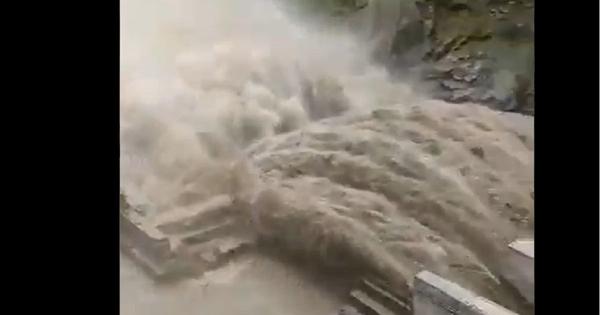MASSIVE CLOUDBURST HITS CHOSITI, KISHTWAR: DOZENS DEAD, HUNDREDS AFFECTED
SHORT SUMMARY
A sudden and massive cloudburst struck Chositi (also reported as Chasoti/Chishoti) village in Jammu & Kashmir’s Kishtwar district on August 14, 2025, triggering flash floods and landslides that swept away homes, vehicles and a community kitchen where pilgrims were gathered. Early official tallies vary — several dozen people have been killed, with reports of 30–40 fatalities, dozens injured, and hundreds rescued or still missing as search-and-rescue operations continue. Central and local disaster response teams including NDRF, SDRF, the Army and police have been mobilised, and senior leaders have pledged assistance. The situation on the ground remains fluid as teams try to reach remote pockets cut off by washed-out roads.
THE MOMENT IT HAPPENED — WHAT WE KNOW RIGHT NOW
Have you ever seen a mountain river turn into a wall of water? That’s effectively what locals in Chositi witnessed when a cloudburst — a very intense, highly localized downpour — collapsed a slope and unleashed torrents down narrow valleys. The rain didn’t just pour; it punched through, sending a mix of water, boulders and debris sweeping across the village and the route to the Machail Mata shrine. Multiple media outlets and officials report dozens of deaths, many injured, and hundreds either rescued or unaccounted for as rescue teams scramble through broken roads and mud-choked trails
The exact fatality numbers vary between sources — India Today reported at least 33 dead with over 220 missing, while other outlets report figures in the 30–40 range and dozens injured. Why the discrepancy? In fast-moving disasters, initial counts are chaotic: people are transported to different hospitals, some areas are cut off, and numbers change as rescue teams access new pockets. I’ll walk you through the best, most reliable pieces of information available and point out where uncertainty remains.
WHERE DID THIS HAPPEN — A NOTE ON SPELLINGS AND PLACES
The affected spot appears under slightly different spellings in media reports — Chositi, Chasoti, Chishoti or Chosti — which is common for small Himalayan hamlets when English transliterations vary. What’s consistent is location: the incident happened in the Paddar/Padder area of Kishtwar district in Jammu & Kashmir, along the approach to the Machail Mata pilgrimage (a popular annual yatra). Chositi is described as the last motorable village en route to the shrine, which makes rescue and relief particularly difficult because the final stretches are steep, narrow and often reachable only on foot or by limited transport.
WHO WAS AFFECTED — PILGRIMS, LOCALS, AND SECURITY PERSONNEL
One of the heartbreaking elements of this tragedy is timing: hundreds of devotees were on the Machail Mata yatra route, and many were gathered near a makeshift community kitchen (langar) when the cloudburst sent floodwater surging through. That kitchen, intended to feed pilgrims, was reportedly washed away along with nearby structures — a grim example of how natural disasters can concentrate casualties in communal gatherings. Reports also indicate that among the dead there were security personnel present on duty, magnifying the loss felt by families and the administration.
What does this mean for survivors? Imagine being several kilometers from the nearest major town, with the road torn up and communications patchy — that’s where many of these people found themselves. Rescue teams have been working around the clock to extract those trapped and transport the seriously injured to hospitals. The severity of injuries ranges from fractures and deep cuts to hypothermia and shock, and medical evacuation in rugged terrain is always complicated.
RESCUE RESPONSE — WHO’S ON THE GROUND AND WHAT THEY’RE DOING
When disaster strikes in remote mountains, response hinges on speed, coordination and logistics. Official sources confirm large-scale mobilization: the National Disaster Response Force (NDRF), State Disaster Response Force (SDRF), police teams, the Army, and local volunteers are all engaged in search-and-rescue efforts. Union and state officials have been coordinating relief — Union Minister and local political leaders communicated with district officials to assess the situation and dispatch reinforcements. Air assets, where available and weather permitting, are often used for triage and evacuation but are constrained by cloud cover and narrow valleys.
If you’re picturing a rescue team arriving in a helicopter and sweeping people away to safety — sometimes that happens. But more often, rescuers have to carry people on stretchers across broken ground, use mule or tractor trails, and set up temporary medical camps. Given the scale of the floods and landslides, teams also have to clear debris to reach deeper pockets where people may be trapped under mud or wreckage. It’s gruelling, dangerous work — and speed literally saves lives.
CONCLUSION — A CALL FOR URGENCY AND EMPATHY
What happened in Chositi is a devastating reminder that nature, infrastructure and human gatherings interact in ways that can turn celebration into calamity in minutes. Rescue work is heroic, but preventable loss requires honest conversation, investment in resilient infrastructure and respect for fragile mountain systems. For now, thoughts and energy should go towards saving lives, supporting survivors, and ensuring that reconstruction is done with the future in mind — safer, smarter and more sustainable.
FREQUENTLY ASKED QUESTIONS (5 UNIQUE)
Q1: How many people have died and gone missing in the Chositi cloudburst?
A1: Early reports vary; major outlets have reported casualty figures in the 30–40 range with hundreds reported missing or unaccounted for during ongoing rescue operations. Numbers are still being updated as teams reach cut-off areas.
Q2: What caused the disaster — was it a dam or man-made failure?
A2: Initial reports attribute the immediate cause to a natural phenomenon: a cloudburst that triggered flash floods and landslides. While human alterations to the landscape can worsen impacts, there’s no single report naming a dam failure as the trigger for this event. Investigations typically follow to determine all contributing factors.
Q3: Are rescue teams from the centre involved?
A3: Yes. The NDRF, SDRF, Army, police and local volunteers have all been reported to be engaged in rescue and relief, and central leaders have offered assistance. Weather and terrain conditions limit how quickly some operations can proceed.
Q4: Why do cloudbursts hit mountains so hard?
A4: Mountains have steep slopes and narrow valleys that funnel water quickly; heavy localized rainfalls (cloudbursts) overwhelm natural drainage, causing sudden, powerful flash floods and landslides — the steeper and more altered the slope, the greater the risk
Q5: How can readers donate or help?
A5: The most effective support is through official government relief funds, verified disaster relief NGOs, or local district administration collection points. Cash donations routed via verified channels are usually the fastest way to deliver help. Verify any fundraiser before donating.




